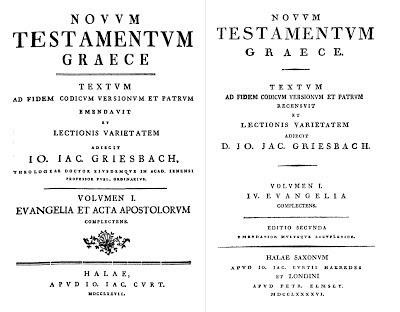In a 1735 book I found a nice page with a listing of abbreviations in Greek manuscripts. The book is Johannes Alberti, Glossarium Graecum in sacros Novi Foederis libros. Ex MSS. primus edidit, notisque inlustravit ... Accedunt eiusdem miscellanea critica in glossas nomicas, Suidam, Hesychium et index auctorum ex Photii lexico inedito (Leiden: Luchtmans, 1735).
It was really the time that critics such as Wettstein and Alberti started to carefully study minuscule NT manuscripts, and also the additional information found therein, such as scholia and lists, etc..
Of course those scholars had to learn how to read the handwriting. The image below, in a way, records how Alberti did just that.
It is a folded sheet, between the preliminary matter and the first page of the Glossarium proper. I found the book at Google Books (just try "inauthor:alberti intitle:glossarium"), but the table was only partly visible, because the GB operators more often than not do not bother folding out such pages. Luckily, the book is available in various copies, with different ways of folding the page, so that it was possible to reconstruct the complete page.
ANTW is a weblog maintained by the Amsterdam Centre for New Testament Studies (ACNTS). Contributors are the staff of the New Testament department of the Faculty of Theology at VU University Amsterdam. Interests of the weblog include Biblical Exegesis and Theology, Textual Criticism and Bible Software.
Friday, July 19, 2013
Wednesday, July 03, 2013
... is in the details
Recently I took a closer look at the title pages of Tischendorf’s seventh and eighth major Greek New Testament edition. As often, the small differences are the most interesting. To name just one: in 1859, Tischendorf edited the text afresh “ad antiquos testes”, “according to old witnesses”; in 1869, the witnesses have become “antiquissimos”, ”the oldest” or ”very old”.

Another example? Another example:
Griesbach’s first and second editions of 1777 and 1796, respectively (the dates are for the first volume only).
The change that caught my eye was between “emendavit” in 1777 and “recensuit” in 1796. Would it be too far-fetched to see the latter as an indication of things to come in the 19th century?
In any case, it is the term used by Tischendorf as well.
There is also a nice parallel in another change: it would seem that the less a scholar's name is established, the more important it is to include any marks of distinction that may apply ...
[For Tischendorf: HT Bart Kamphuis]
Labels:
Bart Kamphuis,
Griesbach,
sinaiticus,
Tischendorf
Subscribe to:
Posts (Atom)

